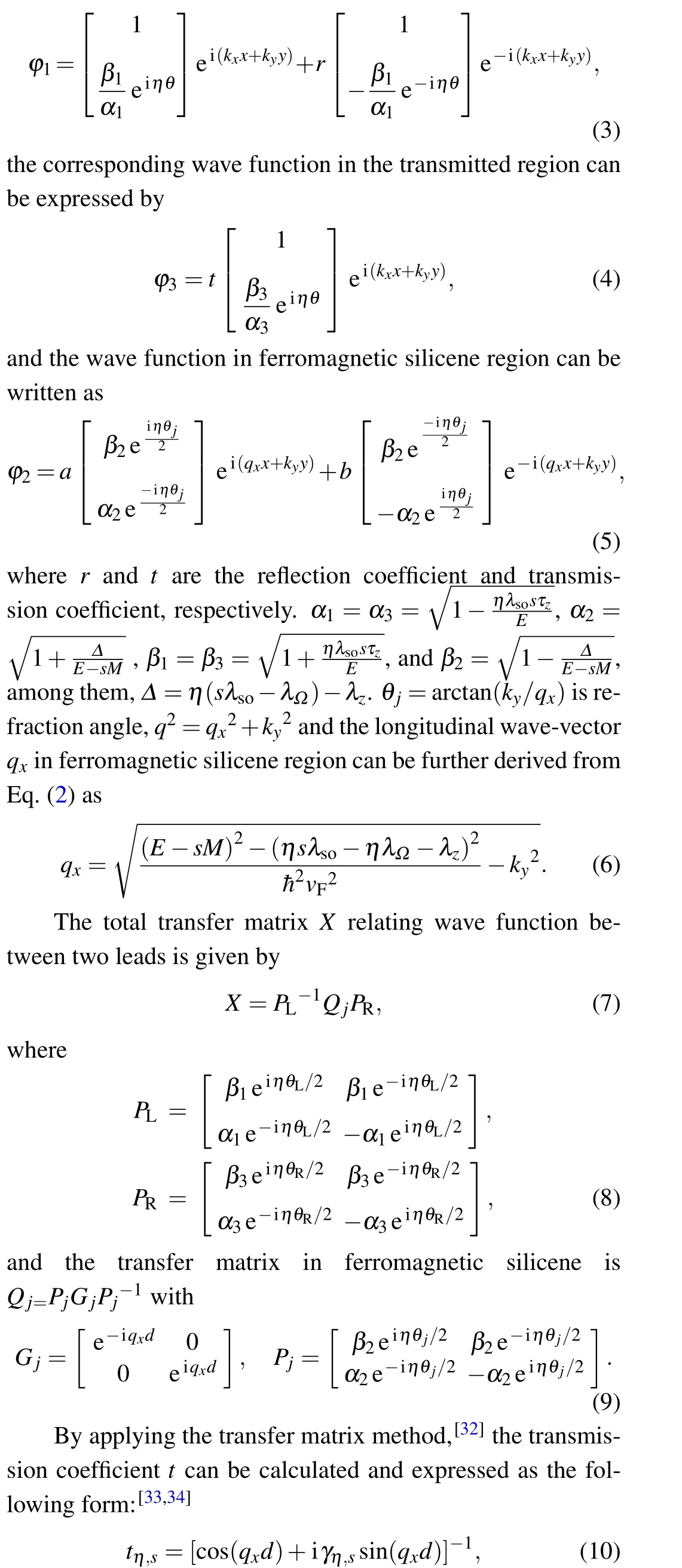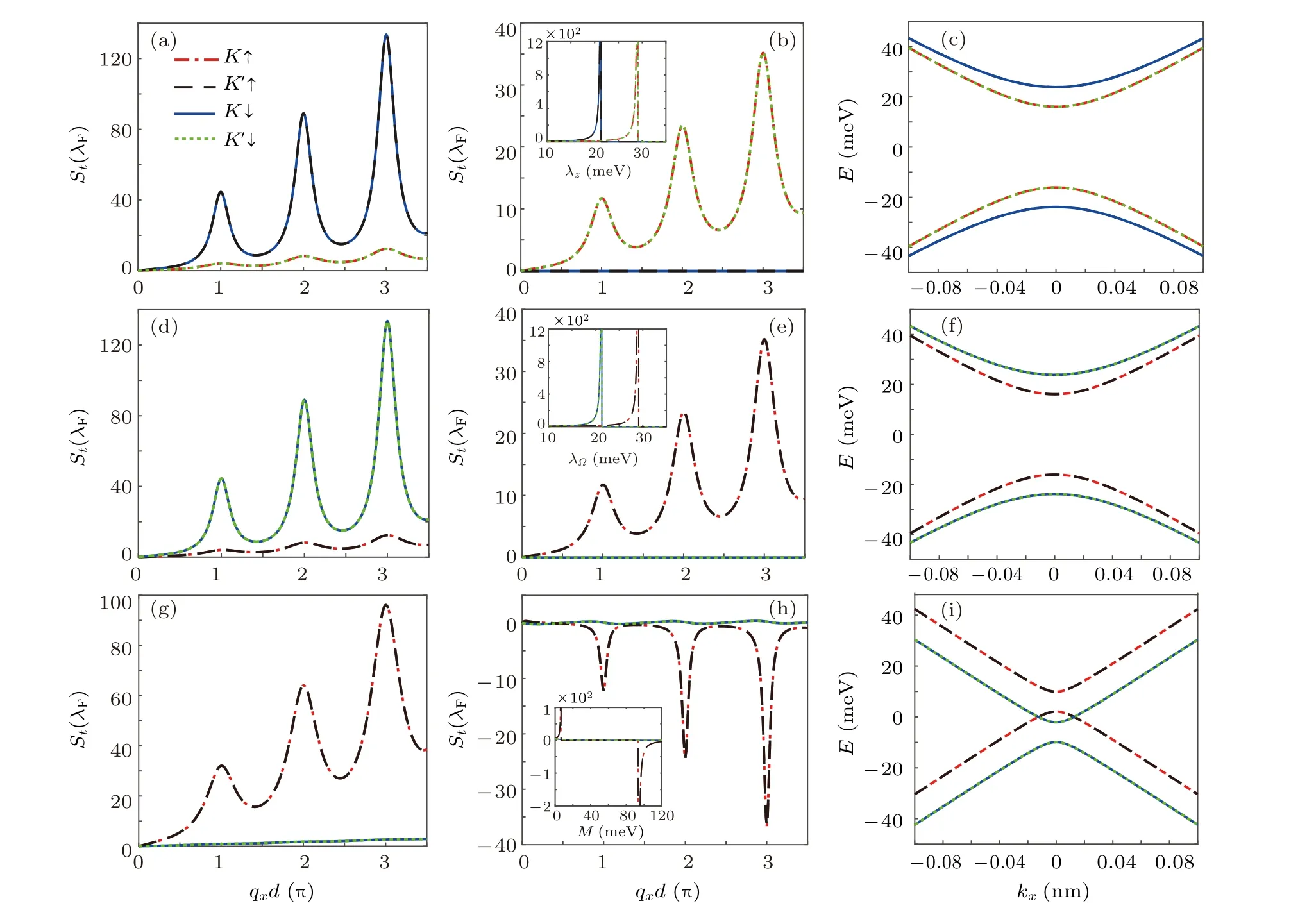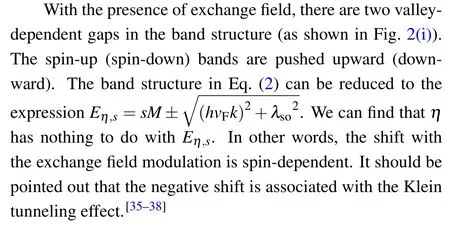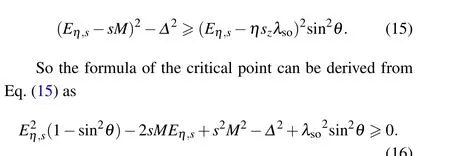Goos–H¨anchen-like shift related to spin and valley polarization in ferromagnetic silicene∗
2021-10-28MeiRongLiu刘美荣ZhengFangLiu刘正方RuoLongZhang张若龙XianBoXiao肖贤波andQingPingWu伍清萍
Mei-Rong Liu(刘美荣) Zheng-Fang Liu(刘正方) Ruo-Long Zhang(张若龙)Xian-Bo Xiao(肖贤波) and Qing-Ping Wu(伍清萍)
1Department of Applied Physics,East China Jiaotong University,Nanchang 330013,China
2School of Computer Science,Jiangxi University of Traditional Chinese Medicine,Nanchang 330004,China
Keywords: Goos–H¨anchen-like shift,silicene,polarization
1. Introduction
The Goos–H¨anchen (GH) shift was first discovered by Goos and H¨anchen in 1947.[1,2]This is an optical phenomenon, which means that when a very narrow beam is totally reflected, the reflection point and the incident point are not at the same position, and the reflected light has a very small lateral shift at the interface relative to geometric optics.The GH shift is widely used in integrated optics,near-field optics and optical devices. For example, optical switch based on GH shift,[3]solution concentration sensor[4]and temperature sensor.[5]In addition, quantum GH effect has been considered in electronics. For example, it has shown that the effect at a p–n interface in graphene is strongly dependent on the sublattice degree of freedom.[6]And it has been studied in graphene double barriers,[7]which provides feasibility for making valley splitter. Furthermore, the GH effect can be affected by the presence of a magnetic field in graphene triangular barrier.[8]This GH shift can be applied to spintronics to obtain spintronic devices.[9]Compared with traditional electronic devices,spintronic devices have the advantages of large information storage capacity, fast data processing speed, and low power consumption.[10]
Combining semiconductor materials with the optical phenomenon[11,12]of GH shift, Chenet al.[13–15]extended it to partial reflection to obtain Goos–H¨anchen-like(GHL)shift,which is similar to but different from GH shift and has nothing to do with evanescent waves. Researchers studied GHL shift on various graphene-based nanostructures in single barrier,[16]and have proved that the GHL shift can be adjusted by changing the electrostatic potential and the induced gap. The GH shift in Weyl semi-metallic electrons is analogous to that in graphene.[17]It is also found that the GHL shift, as the function of the barrier’s width and incidence angle,can be negative and positive in the cases of Klein tunneling and classical motion. Studies in strained graphene[18–20]have shown that the GHL shift is the function of the strain tensor and direction. In a gated monolayer WS2,[21]the GHL shift of spin-polarized electrons extremely rely on the width of the gated region and can be positive or negative in both Klein tunneling and classical motion regimes.
In addition, silicene is similar in structure and physical properties to graphene. However, there is a significant difference between silicene and graphene, the strong spin–orbit coupling (SOC), which results in a band gap in the energy spectrum of silicene.[22,23]It has demonstrated that for a normal/ferromagnetic/normal silicene junction, the GHL shift is negative and positive.[24,25]However, there are few further studies on simultaneous valley-and spin-polarized GHL shift in silicene. Recently, it is reported that the off-resonant circularly polarized light can open a band gap of the Dirac cone in silicene,[26–28]which can lead to the valley separation.[29]In this paper, we investigate the GHL shift of a single silicene barrier with the external perpendicular electric field,the exchange field and the off-resonant circularly polarized light.The GHL shift of spin-polarized can be achieved in silicene with off-resonant circularly polarized light or the exchange field. The addition of the external perpendicular electric field can make the GHL shift of the system have the characteristics of spin polarization and valley polarization at the same time.What’s more, the continuous exchange field can realize the transition between positive and negative GHL shifts.
2. Model and formalism
We place a ferromagnetic insulator on the bottom of the silicene to form a ferromagnetic silicene. The external perpendicular electric fieldλzand off-resonant circularly polarized lightλΩare applied to the ferromagnetic silicene area,as shown in Fig.1. The low-energy effective Hamiltonian of the ferromagnetic silicene region with the external perpendicular electric field and off-resonant circularly polarized light can be written as[28–31]

Here,vF≈5.5×105m/s is the Fermi velocity,λso≈3.9 meV is the spin–orbit coupling in silicene,τx,y,zare the Pauli matrixs in sublattice pseudo-spin space,Mis the effective exchange field obtained by the magnetic neighboring effect of ferromagnetic insulators,λzis the external perpendicular electric field andλΩis the effective energy induced by the off-resonant circularly polarized light.

Fig.1. Schematic diagram of the normal-ferromagnetic-normal silicene under the external perpendicular electric field λz and off-resonant circularly polarized light λΩ. The transport direction is along the x-axis.
Upon diagonalization of the Hamiltonian,the energy dispersion can be calculated as following:




3. Results and discussion
Firstly,we calculate the GHL shift as a function ofqxdat the different external perpendicular electric field,off-resonant circularly polarized light or the exchange field. Herein,Sthas been rescaled byλF,whereλFis the Fermi wavelength of electrons,whiledis rescaled byqx−1.
We discuss the GHL shift for silicene with different external perpendicular electric field strength (as seen in Figs. 2(a)and 2(b)). The shifts of spin-up electrons atKvalley(K↑)are the same as that for spin-down electrons atK′valley (K′↓),and the shifts of spin-down electrons atKvalley(K↓)are also the same as that for spin-up electrons atK′valley (K′↑). Asλz= 25 meV (as shown in Fig. 2(b)), the shifts of spin-up(spin-down)electrons atK(K′)valley are high,while the shifts of spin-down(spin-up)electrons atK(K′)valley vanish. The maximum value of the GHL shift corresponds to the resonance conditionsqxd=kπ(k=0,1,2,3,...),which is given as

For sake of clearness, the inset of Fig. 2(b) further displays the magnitude ofSt-peak versus external perpendicular electric field atqxd=3π, where the GHL shift demonstrates obvious jump. For example,the shift values of spin-up(spindown)electrons atK(K′)valley suddenly change from a large positive shift to zero whenλz ≈21 meV,while the shift values of spin-down (spin-up) electrons atK(K′) valley emerge the same adjustment atλz ≈29 meV.


Fig.2. GHL shift for the transmitted beam as a function of barrier width d with parameters E =50 meV,λso =3.9 meV,and θ =π/3. (a)λz =20 meV, (b)λz =25 meV. (d)λΩ =20 meV, (e)λΩ =25 meV. (g) M=6 meV, (h)M=100 meV. Panels(c), (f)and (i) are electronic band structures for spins and valleys corresponding to(a),(d)and(g),respectively.
Under the modulation of the off-resonant circularly polarized light (as seen in Figs. 2(d) and 2(e)), the values of CHL shift have no difference, which is similar to that of Figs. 2(a) and 2(b). However, the shifts of the spin-up electrons are identical, and the spin-down of that are also identical. AsλΩ= 25 meV (as shown in Fig. 2(e)), the shifts of spin-up electrons become higher, while the shifts of spindown electrons vanish. In the inset of Fig.2(e),the values of all shifts increase first, then rapidly decrease to zero. However,the position where the shift of the spin-up electrons and the spin-down electrons vary to zero is different. We can find that the shift of spin-up electrons exhibits a mutation atλΩ ≈21 meV, and comparably, the shift of spin-down electrons is atλΩ ≈29 meV.

The electrons shifts are also spin-dependent with only adjusting the exchange field (as shown in Figs. 2(g) and 2(h)).But the difference is that the fluctuation in shifts of spin-down electrons is very weak. WhenM=6 meV,the shifts of spinup electrons are positive.While,for the case ofM=100 meV,the shifts of spin-up electrons are negative. To show this reversal more clearly, we plotSt-peak atqxd=3πin the inset of Fig. 2(h). With the value of the exchange fieldMincreasing from 0 meV to 6.65 meV, the shift value of spin-up electrons gradually increases to positive peak value, then it abruptly reduced to zero. WhenMsurpasses to the critical value 93.34 meV, the shift value suddenly changes from 0 to negative peak value. Then it increases to zero gradually with the further increasing exchange fieldM. Such a changed shift is closely related to the longitudinal wave-vector which is determined by the exchange fieldM.

In order to explore the effect of combined modulation,the calculated results for GHL shift are shown in Fig.3. The relationship between the GHL shift and incident energy is discussed when both off-resonant circularly polarized light and the exchange field are considered (as seen in Fig. 3(a)). The electrons shifts separate two spin-dependent beams for a specific valley. A strong contrast in amplitude can be observed for spins orientation. Specifically,at the same valley,the shift value of the spin-up electrons is about six times that of the spin-down electrons. These maximum values correspond to the transmission resonances and demonstrate the spin splitting of charge carriers in silicene, which means that the shift can be generated and controlled by the exchange field and offresonant circularly polarized light. The equation of propagation mode is given as

Only considering off-resonant circularly polarized light and the exchange field in this structure,we can obtain that the values of shift are 0 whenE1,1=E−1,1< 101.4145 meV andE1,−1=E−1,−1<247.0904 meV. Then, with increasing exchange fieldM, it reaches the maximum, and finally decay.The band gap forK↑(K↓)is also the same as that ofK′↑(K′↓)(as seen in Fig.3(a)).So,the GHL shift with both off-resonant circularly polarized light and the exchange field is only spindependent.
The GHL shift is spin-polarized when only the exchange field is modulated. By further involving a nonzero external perpendicular electric fieldλz, we can find that the shifts of different valleys can be distinguished weakly (as seen in Fig.3(b)). Spin-up and spin-down states are mixed at the energy band intersection and spin degeneracy is broken. Similarly, from Eq.(15), the maximum shifts ofK↑,K′↑,K↓andK′↓occur at 156.1 meV,163.9 meV,3.9 meV and−3.9 meV,respectively. Thus, the GHL shift under the external perpendicular electric field combined with exchange field is partial spin-and valley-polarized.
The GHL shifts with the external perpendicular electric field and the off-resonant circularly polarized light comodulated are plotted in Fig. 3(c). From Eq. (15), we can obtain that the four spectras change from zero to the maximum atE−1,1= 111.9965 meV,E−1,−1= 127.6214 meV,E1,1= 192.0813 meV andE1,−1= 207.6902 meV, respectively,then oscillation decay.Moreover,the shift value of electrons fromK′valley is a quarter ofKvalley,which can be perfectly reflected in Fig.3(c). The band gap of spins and valleys are both broader,and the gaps with different spins and valleys do not coincident. Since the both spin-and valley-dependent beams can be well separated under the external perpendicular electric field and off-resonant circularly polarized light modulations,the GHL shift is spin and valley polarization.
Considering all three external modulations, the polarization is more pronounced (as seen in Fig. 3(d)).The spin and valley are separate completely, which features that fourSt-peaks appear inE−1,−1= 65.2144 meV,E1,−1=138.9411 meV,E−1,1=211.6936 meV andE1,1=284.1940 meV, respectively. These conclusions can also be proved from Eq.(15). More interestingly, the values of GHL shifts atK′↓,K↓,K′↑, andK↑increase in turn. Based on Eq. (2), one can find that the valley and spin degenerate are lifted and different gaps are induced at different spins and valleys (as seen in Fig. 3(d)). Therefore, both spin and valley polarization are striking in this case.Since the above researches were conducted under the fixed value of the field strength, we further explore the influence of the continuous off-resonant circularly polarized light,the external perpendicular electric field or the exchange field on the GHL shift,respectively.Figure 4(a)displays the shift as a function of the circularly polarized light modulation. As we can see, the shift of spin-down electrons occur, but the electrons shift of spin-up electrons is negligible. The formula of the critical point can be derived from Eq.(15)as

The shift of spin-down electrons increases oscillatingly,and then alters to zero abruptly. However, the shift values of spin-up electrons are negligible. The shift values of spindown electrons atKandK′become maximum at the position ofλΩ=31.2036 meV andλΩ=71.2036 meV, respectively,which can be derived from Eq.(17).

Fig. 3. GHL shift as a function of incident energy E with λso =3.9 meV, θ =π/3, and d =40 nm. (a) λΩ =80 meV, M =20 meV and λz=0 meV. (b)λΩ =0 meV,M=20 meV and λz=20 meV. (c)λΩ =80 meV,M=0 meV and λz=20 meV. (d)λΩ =80 meV,M=20 meV and λz=20 meV.
The effect of the external perpendicular electric field on the GHL shift in Fig.4(b)is similar to that of off-resonant circularly polarized light modulation in Fig. 4(a). However, the values of the electrons shift for the same valley are different.In the case,with the external perpendicular electric fieldλzincreasing to 55.0709 meV and 102.8709 meV, from Eq. (17),the shifts ofK′↓andK↓increase gradually to maximum.
While under a continuous range of the exchange field modulation, in Fig. 4(c), all spin up-related peaks are displayed as a negative value, and spin down-related peaks are displayed as positive values. For valleys with the same spin direction, a strong amplitude contrast can be observed.The GHL shifts ofK′↓,K ↓,K′↑, andK ↑convert from zero to maximum in turn, and then the oscillation decrease.WhenM=11.5695 meV, 44.3547 meV, 106.2744 meV and 137.4917 meV, the values of GHL shift reach maximum,which can be derived from Eq. (17). Therefore, the filtering function can be modified by adjusting the values of the three fields.
From Eq. (16), we can find that the incident angle can also affect the GHL shifts of the electrons. The GHL shifts with different incident angles are demonstrated in Fig. 5. Indeed,it is shown that valley and spin are always polarization,and the GHL shift is closely related to the incident angle. In Fig.5(a),for the incident angleθ=π/18,the maximum shift ofK′valley is always smaller than that ofKvalley. Increasing the incident angle to 4π/18 (see Fig. 5(b)), the magnitude of the shift value is six times that of the original value in Fig.5(a).By further comparing with the corresponding results forθ=8π/18 in Fig.5(c),the spin up-related peaks become larger than the spin down-related peaks. We can regulate the GHL shift to higher values by increasing incident angle,which can be a good way to make valley correlation filters.4

Fig.4. (a)GHL shift as a function of off-resonant circularly polarized light λΩ with M=20 meV,and λz=20 meV. (b)GHL shift as a function of the external perpendicular electric field λz with M =40 meV, and λΩ =20 meV. (c) GHL shift as a function of the exchange field M with λΩ =60 meV,and λz=20 meV. Other parameters are λso=3.9 meV,θ =π/3,E=50 meV,and d=40 nm.

Fig.5. GHL shift for the transmitted beam as a function of incident energy E with λso=3.9 meV,M=20 meV,λΩ =80 meV,λz=20 meV,and d=40 nm. (a)θ =π/18. (b)θ =4π/18. (c)θ =8π/18. The regime for 0 In summary, the Goos–H¨anchen-like shift for single silicene with off-resonant circularly polarized light, exchange field and the external perpendicular electric field has been studied.It was found that the GHL shift of silicene with an external perpendicular electric field cannot distinguish valleys or spins. Only with the exchange field or the off-resonant circularly polarized modulation,the GHL shift was spin-dependent.Particularly,not only under the external perpendicular electric field and off-resonant circularly polarized light modulations but also under the exchange field and the external perpendicular electric field modulations,the GHL shift is both spin-and valley-polarized. Furthermore, by controlling the strength of these three fields appropriately,the spin-and valley-polarized of the shift is more noticeable. The magnitude of the shift can also be changed by adjusting the incident angle. We hope our findings can be helpful for the electrical control of spin and valley filtering and the application of quantum information.4. Conclusion
杂志排行
Chinese Physics B的其它文章
- Physical properties of relativistic electron beam during long-range propagation in space plasma environment∗
- High winding number of topological phase in non-unitary periodic quantum walk∗
- Widely tunable single-photon source with high spectral-purity from telecom wavelength to mid-infrared wavelength based on MgO:PPLN∗
- Control of firing activities in thermosensitive neuron by activating excitatory autapse∗
- Adaptive synchronization of chaotic systems with less measurement and actuation∗
- Dynamics analysis of a 5-dimensional hyperchaotic system with conservative flows under perturbation∗
